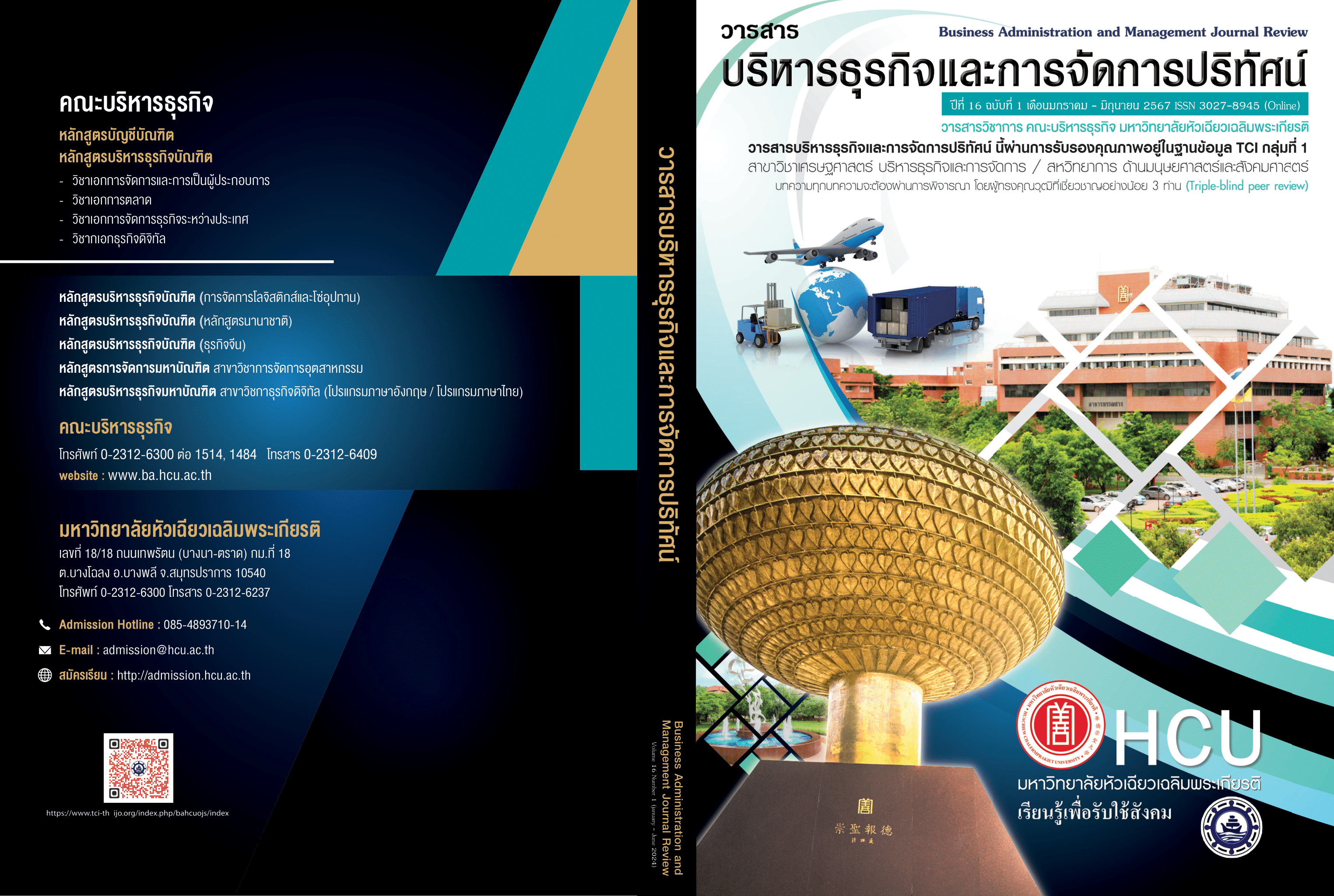Causal Model of Factors Influencing the Business Performance of Small and Medium Enterprises in Bangkok Metropolitan Region
Keywords:
Business performance, Innovation, Marketing orientation, The entrepreneur’s characteristicsAbstract
The objective of the study was to 1) examine the congruence between the empirical data and a causal model of the factors affecting the implementation of SMEs in the Bangkok Metropolitan Region; 2) study the direct, indirect, and total effects of the factors on the
implementation of SMEs in the Bangkok Metropolitan Region, and 3) develop a causal model of the factors affecting the implementation of SMEs in the Bangkok Metropolitan Region. The
researcher used a quantitative research method in which a questionnaire was used for the
collection of the data. The validity of the instrument tested by Cronbach’s alpha = 0.953, representing high reliability. Therefore, 250 sets of the questionnaire were used for collecting the data from SME entrepreneurs in the Bangkok Metropolitan Region. Then, the data were analyzed by using descriptive statistics, confirmatory factor analysis (CFA), and structural causal relationship analysis. Additionally, the entrepreneur’s characteristics and marketing orientation directly and positively affected the business performance. However, innovation, marketing
orientation, and the entrepreneur’s characteristics were useful to SMEs for creating a competitive advantage in business groups in order to achieve long-term advantages of success over competitors.
References
กัลยา วานิชย์บัญชา. (2554). สถิติสำหรับงานวิจัย. (พิมพ์ครั้งที่ 6). กรุงเทพฯ:สำนักพิมพ์แห่งจุฬาลงกรณ์มหาวิทยาลัย.
กัลยา วานิชย์บัญชา. (2552). การวิเคราะห์ข้อมูลหลายตัวแปร (พิมพ์ครั้งที่ 3). โรงพิมพ์: บริษัท ธรรมสาร จำกัด.
มรกต กำแพงเพชร, สวรรยา ธรรมอภิพล และ นรินทร์ สังข์รักษา. (2562). คุณลักษณะผู้ประกอบการเกษตรกรที่ประสบความสำเร็จในธุรกิจเกษตรสีเขียว. วารสารธุรกิจปริทัศน์, 11(1), 262-275.
ศานสันต์ รักแต่งาม. (2559). อิทธิพลของคุณลักษณะการเป็นผู้ประกอบการของนักลงทุนที่มีผลต่อความสำเร็จใน การลงทุนผ่านการมุ่งเน้นการแข่งขันของนักลงทุนรายย่อยภายในตลาดหลักทรัพย์แห่งประเทศไทย. ปริญญานิพนธ์ บริหารธุรกิจมหาบัณฑิต,มหาวิทยาลัยศิลปากร.
สำนักงานส่งเสริมวิสาหกิจขนาดกลางและขนาดย่อม. (2562). อัตราการขยายตัวของ GDP SME และ GDP ประเทศ ปี พ.ศ. 2557-2562. https://www.sme.go.th/upload/mod_download/download-20191203085026.pdf
สำนักงานพัฒนาเศรษฐกิจและสังคมแห่งชาติ. (2562). ปัญหา SMEs ผลิตภัณฑ์ภาคและจังหวัดแบบปริมาณลูกโซ่ 2561. https://www.nesdc.go.th/ewt_dl_link.php?nid=5628&filename= gross_regional.สำนักปลัดกรุงเทพมหานคร. (2561). นโยบายการพัฒนากรุงเทพมหานคร. http://www.oic.go.th/FILEWEB/CABINFOCENTER9/DRAWER072/GENERAL/DATA0000/00000391.PDF.
Basco, R., Hernández-Perlines, F., & Rodríguez-García, M. (2019). The effect of entrepreneurial orientation on firm performance: A multigroup analysis comparing China, Mexico, and Spain. Journal of Business Research, 13(2), 101-110.
Burke, W. and G. Litwin. (1992). A Causal Model of Organizational Performance and Change. Journal of Management, 18(1), 523-545.
Cheng, C. C., & Krumwiede, D. (2012). The role of service innovation in the market orientation—new service performance linkage. Technovation, 32(8), 487-497.
Dess, G. G. and Lumpkin, G. T. (2005). The role of entrepreneurial orientation in stimulating effective corporate entrepreneurship. Academy of Management Executive, 19(1), 147-156.
Farrell, M., & Mavondo,F.T. (2004). The effect of downsizing strategy and reorientation strategy on a learning orientation. Personnel Review, 33(4), 383-402.
Hurley, R. F., & Hult, G. T. M. (1998). Innovation, market orientation and organizational learning: An integration and empirical examination. Journal of Marketing, 62(1), 42-54.
Hult, G. T. M., Hurley, R. F., & Knight, G. A. (2004). Innovativeness: impact on business performance. Industrial Marketing Management, 33(1), 429-438.
Kaplan, R. S. and D. P. Norton. (1992). “The Balanced Scorecard - Measures that Drive.” Journal of Occupational and Organizational Psychology, 77(1), 299-306.
Lauro & Vinzi, V., C. (2005). PLS path modeling. Computational statistics & data analysis, 48(1), 159-205.
Likert, R. E. N. S. I. S. (1972). Likert technique for attitude measurement. Social Psychology: Experimentation, Theory, Research, Sahakian, WS (Ed.). Scranton USA: Intext Educational Publishers.
Lumpkin, G. T., & Dess, G. G. (1996). Clarifying the entrepreneurial orientation construct and linking it to performance. Academy of management Review, 21(1), 135-172.
Lin, C. H., Peng, C. H., & Kao, D. T. (2008). The innovativeness effect of market orientation and learning orientation on business performance. International journal of manpower, 12(1), 121-130.
Mintzberg, H. (1973). Strategy-making in three modes. California management review, 16(2), 44-53.
Narver, J. C., & Slater, S. F. (1990). The effect of a market orientation on business profitability. Journal of marketing, 54(4), 20-35.
Nilawan Sawangrat. (2015). The Structural Influence of Entrepreneurship, Marketing Focus, Innovation Focus, and Learning Focus on Organization Performance. Veridian E-Journal, Silpakorn University (Humanities, Social Sciences and arts), 8(3), 958-975.
Schumacker, R. E., & Lomax, R. G. (2010). A beginners guide to structural equation
modeling. New York: Routledge.
Tutar, H., Nart, S., & Bingöl, D. (2015). The effects of strategic orientations on innovation capabilities and market performance: The case of ASEM. Procedia-Social and Behavioral Sciences, 207(1), 709-719.
Wales, W. J., Gupta, V. K., & Mousa, F. T. (2013). Empirical research on entrepreneurial orientation: An assessment and suggestions for future research. International Small Business Journal, 31(4), 357-383.
Wang, D., Su, Z., & Guo, H. (2019). Top management team conflict and exploratory innovation: The mediating impact of market orientation. Industrial Marketing Management, 82(1), 87-95.
Zehir, C., Can, E., & Karaboga, T. (2015). Linking entrepreneurial orientation to firm performance: the role of differentiation strategy and innovation performance. Procedia-Social and Behavioral Sciences, 210, 358-367.
Downloads
Published
How to Cite
Issue
Section
License
Copyright (c) 2024 Business Administration and Management Journal Review

This work is licensed under a Creative Commons Attribution-NonCommercial-NoDerivatives 4.0 International License.
All articles published in the Business Administration and Management Journal Review are copyrighted by the journal.
The views and opinions expressed in each article are solely those of the individual authors and do not represent those of Huachiew Chalermprakiet University or any other faculty members. Each author is fully responsible for the content of their own article. Any errors or issues found are the sole responsibility of the respective author.




